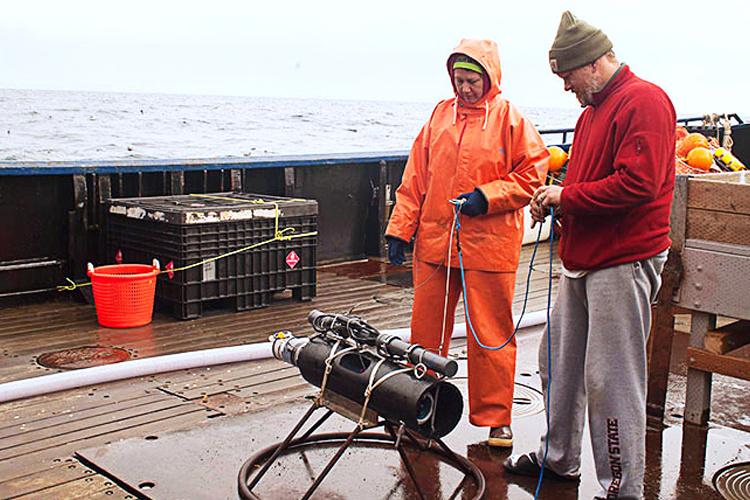Getting Ready
We arrived in Dutch Harbor. After loading the boat with all of our gear we headed out to start the survey. On midnight of the 25th we passed Umnak Island where an active volcano could be seen. Just off Chuginadak, in the Islands of Four Mountains, we began our research trawls, but swift currents slowed our progress.

Rachel's plankton pump ready to be deployed.
Collecting Samples
On day 2, we tested our plankton pump for the first time in the field. The pump is autonomous and does not remain tethered to the boat, so we were all a little nervous sending it off the first time, hoping we’d be successful in retrieving it. As with much of scientific field research, modifications to the design were made with the help of the Sea Storm crew. A few electrical issues were addressed. But, ultimately we were successful!
We collected three samples from bottom depths of over 100 m. On first inspection, we didn’t see any larval fish that were easily visible. The samples will return to Seattle where we’ll analyze them under a microscope for better clarity. A camera was also attached to the pump and it took images of the seafloor habitat in the vicinity of the pump. All of our samples were collected in coral and sponge habitat.
After a day of looking for larval fish and plankton, we are back to conducting research trawls. At the end of several of the upcoming days, we plan to deploy the plankton pump again.

Rachel emptying a sample onto a sieve. The sample will be stored in ethanol and shipped back to Seattle for further analysis.
Meet the Bloggers

Rachel Wilborn is a NOAA Fisheries affiliated biologist with the Alaska Fisheries Science Center’s Resource Assessment and Conservation Engineering Division. Her research focuses on what lives at the bottom of the ocean, specifically sponges and corals, and their role as essential fish habitat. Rachel received a bachelor’s degree in oceanography from the University of Michigan and a master’s degree in biology from the University of West Florida.

Pam Goddard is a NOAA Fisheries affiliated biologist with the Alaska Fisheries Science Center’s Resource Assessment and Conservation Engineering Division. Her recent work has focused on benthic community structure and the role it plays in essential fish habitat. Pam has a bachelor’s degree in biology from Wheaton College, and a master’s degree in fisheries from the University of Washington.



